Muscle Oils
The prevention and treatment of wrinkles has always been a high priority in Beauty Culture. In the early twentieth century there were a range of treatments available, each being a remedy for one or more of the suggested causes of wrinkles: poor diet, sluggish circulation, loss of skin elasticity, loss of subcutaneous fat, and muscle weakness.
Muscle weakness
It was once believed that when the facial muscles were weakened by illness, worry, neglect, advancing years, or ‘overuse’, this caused the skin to sag and fall into folds, resulting in wrinkles. According to this idea, building up the facial muscles would firm the skin, improve facial contours and reduce the production and visibility of lines.
Muscles could be strengthened with facial exercises, massage which was thought to ‘exercise’ them, and/or by ‘feeding’ them with a muscle oil – also known as a suppling oil, toning oil, tissue oil, wrinkle oil, or oily skin food. These oils would penetrate the skin, nourish the muscles and make them full and firm once more.
See also: Facial Gymnastics and Massage, Wrinkles and Double Chins
The rationale behind the use of muscle oils is very similar to that for ‘skin foods’ which were believed to firm the skin by building up subcutaneous fat which, if lacking, could also result in the development of facial lines.
See also: Skin Foods
Vegetable oils were believed to be the best flesh-builders. This axiom was so widespread that they were even recommended in treatments for thinness, e.g., to feed the face during dieting so that it would not look gaunt, or to build up the breasts.
It is easier to “take off” flesh than it is to “put it on,” I have found by experience; but the best treatment is to sleep as much and as often as possible; to eat as much of the most nourishing food as the system will assimilate; to eschew nervous excitement, brain work, and muscular exercise; to get as much fresh air as possible, and as much laughter; to maintain an equable temperament, a contented mind, and a tendency to general indolence. A course of massage and some kinds of medicated baths will greatly help this treatment. Bathing the neck and bosom in cold water for ten minutes daily, and then rubbing in warm olive oil, almond oil, or any good skin-food, will develop this portion of the body in time; but “fattening up” is always a slow process.
(Browning, 1898, pp. 219-220)
See also: Bust Treatments
Eleanor Adair
Perhaps the greatest exponent of muscle oils in the early years of Beauty Culture was Eleanor Adair [b. c.1864]. She constantly advertised the benefits of her Ganesh Eastern Muscle Oil, referring to it as the “The Great Beautifier”.
Ganesh Eastern Muscle Oil
This notably successful preparation has been called “The Great Beautifier.” Great because its qualities and benefits are fundamental, not superficial.
When fatigue, overstrain or neglect cause the muscles which form the contour of the face, to sag, droop and contract, the outer skin becomes loose, wrinkled and lined; hollows and puffiness ensue.
Only by rejuvenating, stimulating and nourishing these tired muscles and tissues until they are healthy, full and firm, will the outer skin stretch over them smoothly and evenly, permitting a natural youthful color to bloom through the cuticle.
This can be accomplished satisfactorily and in surprisingly quick time by use of the Ganesh Eastern Muscle Oil, which is so akin to the natural oils of the skin that the tissues rapidly absorb it and are strengthened by it.
Mrs. Adair’s clients throughout the United States and Europe, who have, by consistent use of “The Great Beautifier,” achieved an ideal complexion, where before there were blemishes, snap their fingers at cosmetics.
If fine lines or heavy wrinkles or hollows mar your face, or if your skin is tinged with sallowness and discolorations, write for a bottle of the Ganesh Eastern Muscle Oil. Begin to use it immediately under Mrs. Adair’s personal directions.(Eleanor Adair advertisement, 1916)
See also: Eleanor Adair
Eleanor Adair was not alone in extolling the benefits of this type of cosmetic with most of the major salon-based companies using muscle oils in their treatments at some time or other.
Formulation
Formulas for muscle oils appeared in most cosmetic chemistry texts right up to the outbreak of the Second World War, after which they disappeared. To feed muscles, they were recommended to be made of a good, heavy ‘nourishing’ oil, such as olive or almond oil.
Tissues oils are applied to the sagging parts of the face and are absorbed by the skin during the hours of repose. They are made from a vegetable oil, with small quantities of a resin, terebene, methyl salicylate, and camphor oil suitable perfumed. An example follows:—
No. 1590
1000 Sweet almond oil. 5 Styrax. 10 Essential oil of camphor. 5 Methyl salicylate. 5 Terebene. 10 Rose centifloria, No 1091. 1035 Rub down the styrax in a warm mortar and add the fixed oil. Then transfer to a bottle and add the other ingredients.
The products are sometimes called Muscle Oils.(Poucher, 1932, pp. 513-514)
Despite the fact that many believed that only natural oils had ‘nutritive value’, mineral oils were also used, either as part of a formulation or in isolation. This was not all bad as the presence of mineral oil gave the muscle oil a continuous lubricating effect, offsetting the fact that vegetable oils sometimes left the skin feeling dry (deNavarre, 1941, p. 283). Being occlusive, mineral oils also helped hydrate the skin and make wrinkles temporarily less visible, although this would not have been considered at the time.
No. 1
Per cent Medium viscosity mineral oil 99.50 Perfume 0.50 No. 2
Per cent Castor oil 10.00 Olive oil 30.00 Mineral oil, medium viscosity 59.60 Preservative 0.15 Perfume 0.25 No. 3
Per cent Cholesterin 2.00 Lecithin 1.00 Olive oil 20.00 Castor oil, odorless 10.00 Mineral oil 56.75 Alcohol 10.00 Perfume 0.25 Procedure: Dissolve the lecithin and cholesterin in the alcohol and add the perfume. The add the solution to the mixed oils.
(Chilson, 1934, p. 320)
Petroleum-based oils were cheaper and had a better shelf-life than vegetable oils but many formulators – particularly those from Europe with long traditions of using biologicals – disagreed with including significant quantities of them. The same objections did not apply to the later inclusion of vitamin-rich oils such as cod-liver, avocado and turtle oil.
See also: Vitamin Creams, Avocado Oil and Turtle Oil
Treatments
Muscle oils were most commonly used in conjunction with a skin food/tissue cream. When applied during a salon facial, the muscle oil would be patted around the eyes and wherever fine lines were found or expected, then covered by a skin food or tissue cream that was applied across the whole face and neck.
Muscle Oil is patted in around the eyes, mouth, nose and forehead, whenever lines appear, as the lines indicate the loss of tonicity in muscles or their inability to respond to stimulant. The Muscle Oil by its nourishing and stimulating qualities assists the muscles in regarding this tonicity.
(Lloyd, 1920)
Muscle oils were most commonly applied before the skin cream but there were variations. In the 1930s, Elizabeth Arden recommended that her Ardena Muscle Oil be applied before patting on Velva Cream or Orange Skin Cream but this changed in the 1960s when she suggesting that her Moisture Oil – a rebadged muscle oil – be applied after these creams for maximum effect.
Muscle oils could also be added to other skin-care cosmetics. For example, in 1935, Barbara Gould recommended that a few drops of her Muscle Oil be added to her Tissue Cream.
When used at home, muscle oils were generally applied at night to help ‘strengthen’ muscles around the eyes and mouth to reduce the formation or appearance of lines and wrinkles in these areas.
1. Pour a small quantity of muscle oil into the left palm.
2. Dip the right facial fingers into the oil and apply it around the eyes and along the mouth lines using a gentle patting movement.
3. Apply the tissue cream to the face and neck in the same manner as the cleansing cream.(Livingstone & Maroni, 1945, p. 48)
Muscle oils were most commonly applied to the face but could also be used on any part of the body that suffered from dry skin. They were considered particularly useful for ameliorating the drying effects of very cold climates.
Marinello Muscle oil, a rich, light weight, free-flowing-oil, which softens the horny outer layer of the skin, and makes it better able to absorb the creams used in massage. It is especially recommended for a dry skin, and even when used alone, it serves as a good lubricant in movements designed to erase fine lines. It is an excellent oil to rub over the whole body after a bath, and is especially recommended for the arms and legs, to prevent chapping in cold weather.
(The science of beautistry, 1932, p. 313)
Before the 1950s it was thought that dry skin was due to a lack of oil so many salons also used muscle oils in dry skin treatments.
For dryness without roughness.
After cleansing the skin, adjust eyepads in place. Then
1. Mix two tablespoonfuls each of emollient cream and muscle oil in a small dish and warm it (under infra-red or other heating device) until it forms a smooth fluid.
2. Soak the gauze square, or the strips, in the oil and place them on the face, and well down over the neck, leaving a small opening below the nostrils.
3. Adjust heater over the face at a comfortable distance and pat the face gently all over, following the general lines of massage, for three to five minutes.
4. Remove gauze, apply sufficient additional emollient cream for free lubrication, and continue with massage as in standard treatment.(Wall, 1961, p. 473)
See also: Dry Skin Treatments
Decline
As with skin foods, the passing of the American Food, Drug and Cosmetic Act and the Wheeler-Lea Act in 1938 resulted in the American Federal Trade Commission (FTC) coming down heavily of cosmetics that made nutritive claims, much to the delight of the American Medical Association (AMA).
[Muscle oil] is the one preparation which physicians like to single out for critical and caustic comment on the ethics of the cosmetic industry, because a vast number of claims have been made for muscle oil with none capable of substantiation. Undoubtedly, muscle oil when properly massage into the skin has a softening effect on the outer or horny layer of the epidermis, but beyond this it is useless.
(Chilson, 1934, p. 319)
Some criticism was a little more strident than this.
One of the worst “fakes” on the beauty market, for which women by the thousands used to fall, was the wrinkle remover, or muscle oil. Believe me there is no such thing. You can’t remove wrinkles with tripe of that nature. If the cuticle is dead, it should be gotten rid of by exercise and massage; if anything will help, it might be a little penetrating cream rubbed into the tissues. But don’t go for those avocado oils, muscle oils and other fancy packages of remover, sold at high prices—they’re worthless.
(Hunt, 1941, p. 62)
The American Food, Drug and Cosmetic Act and the Wheeler-Lea Act only applied in the United States so cosmetic companies were still able to use the term elsewhere. However, unlike the expression ‘skin food’, which continued to be liberally used outside of the United States until the late 1960s, there seems to have been a decline in use of the term ‘muscle oil’ after the Second World War. This does not mean that cosmetic companies did away with using oils; Elizabeth Arden, for example, had a number of them in her range at one time or another including Ardena Special Oil, Special Salon Oil and Firmo-Lift Salon Treatment Oil along with the previously mentioned Muscle Oil and Moisture Oil.
See also: The FDA, FTC and Cosmetics
Facial oils
Although products labelled as muscle oils have disappeared, there is an echo of them in the facial oils on the market today. In a couple of ways these facial oils are similar to the ideal muscle oils of old. They are made primarily of vegetable oils like almond and olive, along with some newer plant oils, like argan. Also, although they do not promise to eliminate wrinkles by building up muscles, these facial oils are also applied for anti-ageing or moisturising reasons, with their antioxidant or special properties being stressed rather than any nutritive qualities unless vitamins are included.
Many people who try these facial oils are unhappy with the result. This may be due to the way they apply the oils and perhaps they could learn a thing or two from the past. Like muscle oils, facial oils should be:
1. Used sparingly, and patted on rather than wiped – otherwise too much will be used;
2. Used on freshly cleansed, moist skin – to increase the dispersion and absorption of the oil; and
3. Patted in before other skin creams or lotions are used.
Should the oily feeling still prove too long lasting, then mixing a few drops of the facial oil into a small portion of a face cream or lotion might also be worth a try.
First Posted: 19th January 2015
Last Update: 28th February 2023
Sources
Browning, E. H. (1898). Beauty Culture. London: Hutchinson & Co.
Chilson, F. (1934). Modern cosmetics. New York: Drug & Cosmetic Industry.
deNavarre, M. G. (1941). The chemistry and manufacture of cosmetics. Boston: D. Van Nostrand Company.
Gattefossé, R. M., & Jonquières, H. (1949). Technique of beauty products. (A.R.I.C., Trans.). London: Leonard Hill.
Hunt, T. (1941). Design for glamour. New York: Prentice-Hall, Inc.
Livingstone, H., & Maroni, A. (1945). Everyday beauty culture. Bloomington, Ill: McKnight & McKnight.
Lloyd, E. (1920). Special lessons. Chicago: Marinello Company.
W. M. Meyer Co. (1936). The cosmetiste: A textbook on cosmetology with special reference to the employment of electricity in the care of the hair, scalp, face, and hands, also permanent waving and hair curling (9th ed.). Chicago, Ill: Author.
Poucher, W. A. (1932). Perfumes, cosmetics and soaps (4th ed., Vol. 2). London: Chapman and Hall Ltd.
The science of beautistry. Official textbook approved for use in all the national schools of cosmeticians affiliated with Marinello. (1932). New York: The National School of Cosmeticians, Inc.
Wall, F. E. (1961). The principles and practice of beauty culture (4th ed.). New York: Keystone Publications.
Wells, F. V., & Lubowe, I. I. (1964). Cosmetics and the skin. New York: Reinhold Publishing Corporation.
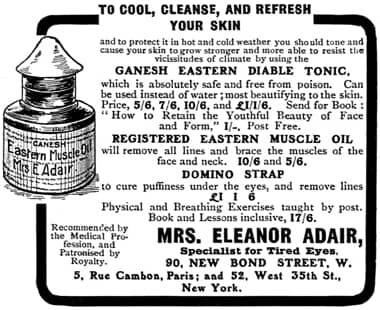
1904 Eleanor Adair Ganesh Eastern Muscle Oil.
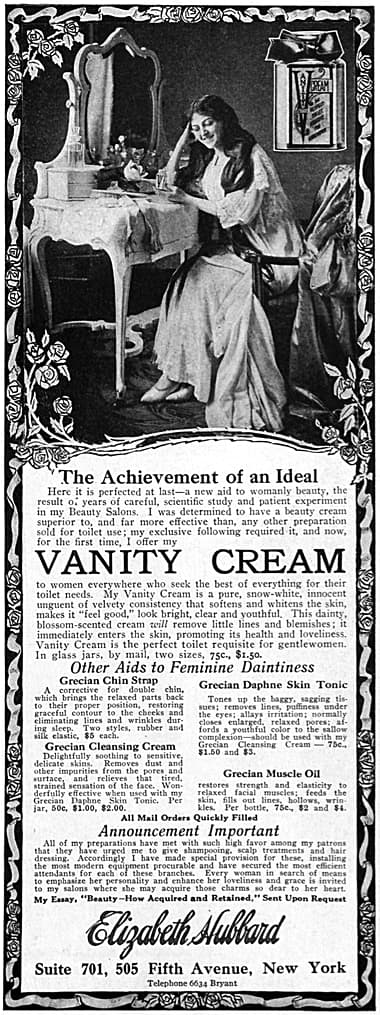
1910 Elizabeth Hubbard Grecian Muscle Oil.
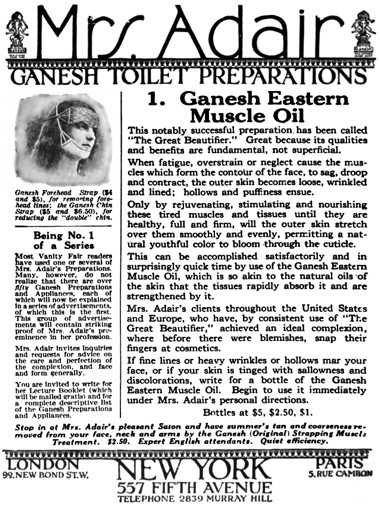
1916 Eleanor Adair Ganesh Eastern Muscle Oil.
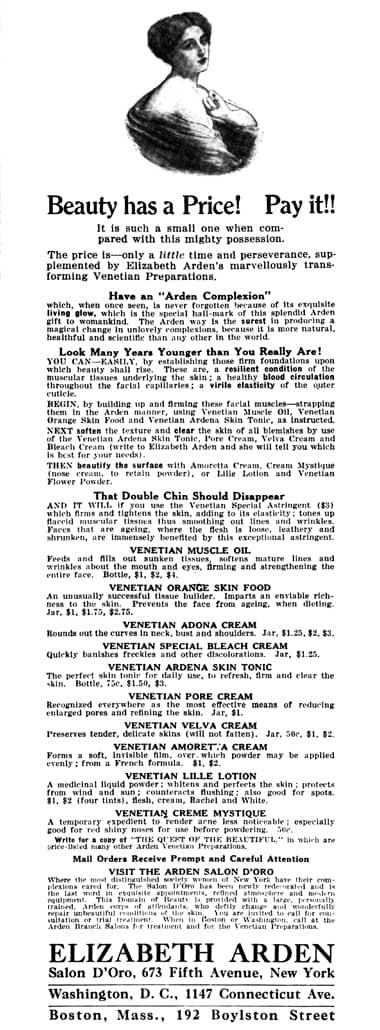
1916 Elizabeth Arden Venetian Muscle Oil.
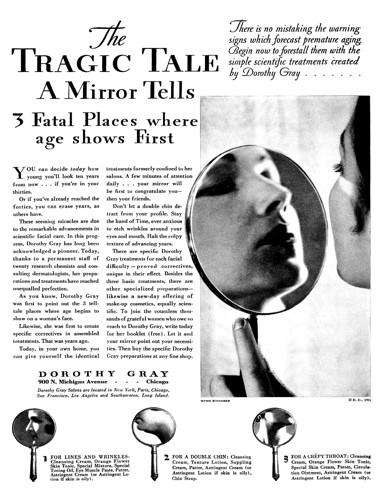
1931 Dorothy Gray Special Toning Oil.
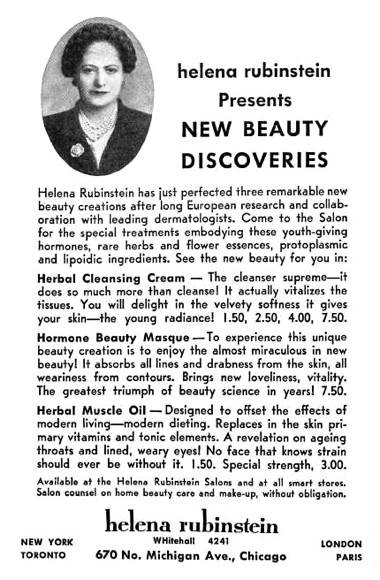
1934 Helena Rubinstein Herbal Muscle Oil.
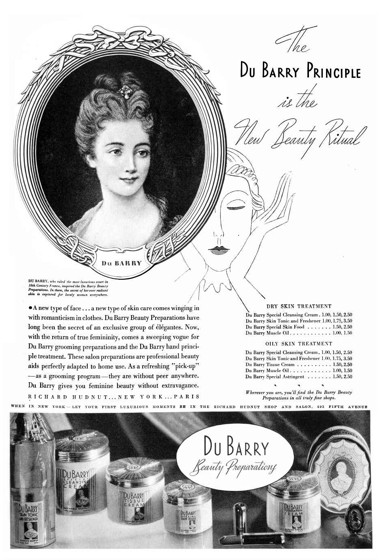
1934 Richard Hudnut Du Barry Muscle Oil.
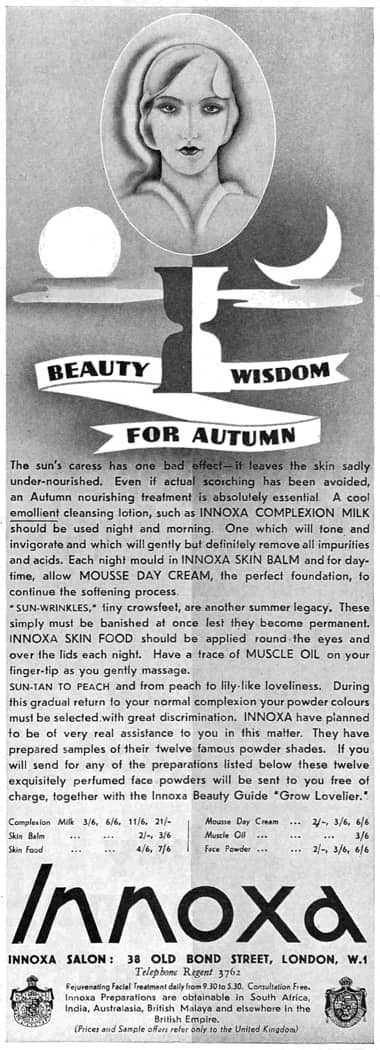
1935 Innoxa Muscle Oil.
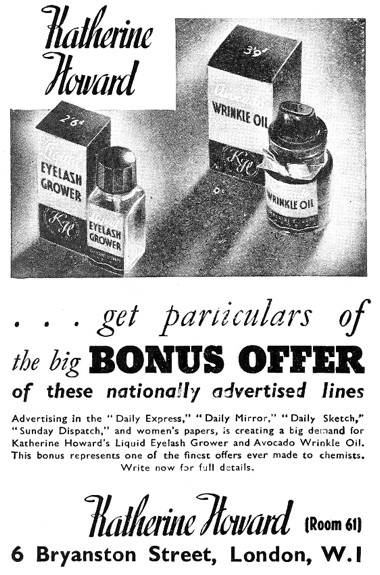
1936 Trade advertisement for Katherine Howard Avocado Wrinkle Oil and Eyelash Grower.
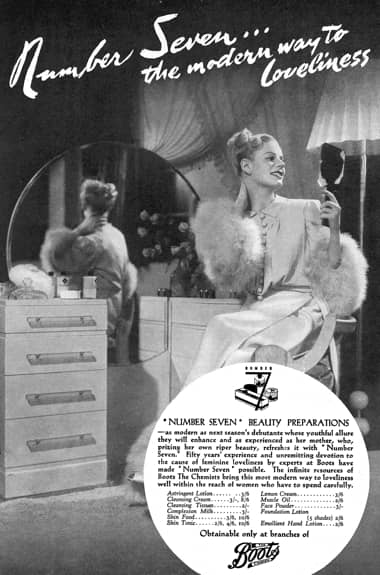
1939 Boots Number 7 Muscle Oil.
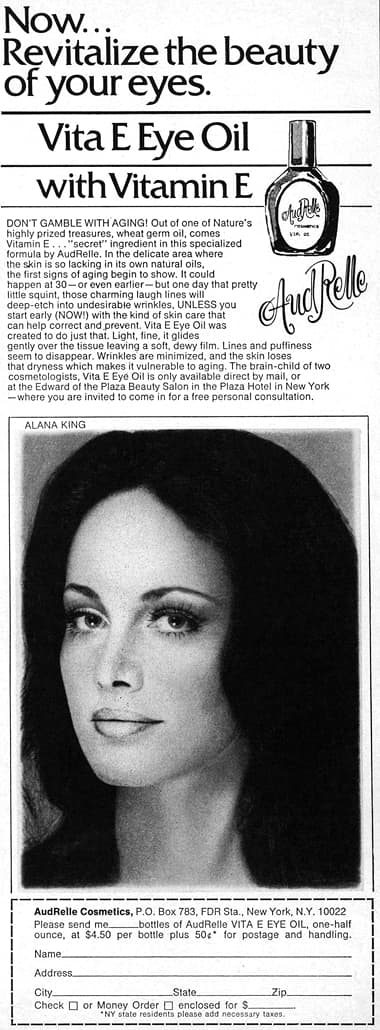
1971 AudRelle Cosmetics Vita E Eye Oil.
